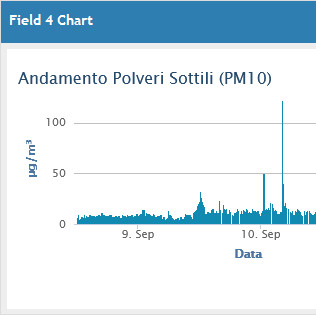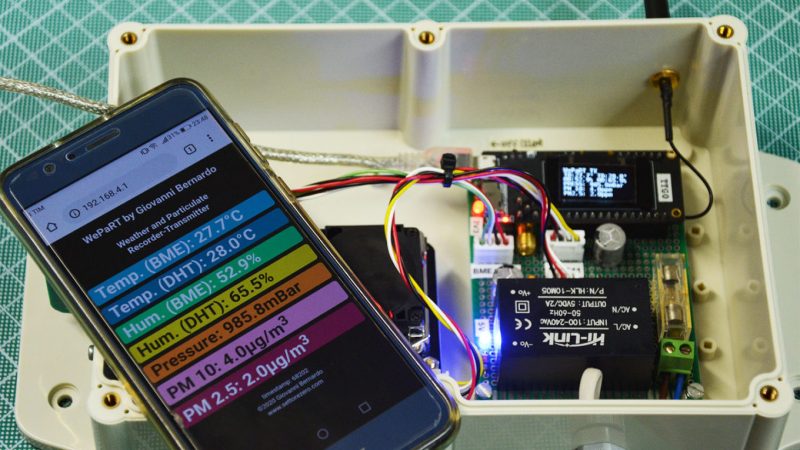We love getting our weather in a flurry of different methods, but have you tried building your own sensor suite to harvest the data for you? [Giovanni ‘CyB3rn0id’ Bernardo] needed to monitor isolated locations outside the reach of WiFi. His ray of hope is an ESP32 controller coupled with a LoRa module to beam data to a remote station that can access the cloud.
 In addition to radios, he poured a deluge of sensors into the base station to read the temperature, barometric pressure, humidity, and fine dust. Why monitor dust as part of weather data collection? Particulate matter has a huge effect on air quality, something of great interest during a respiratory pandemic. For those readers near wildfires, quantifying your air quality (both indoors and out) is certainly of interest. [Giovanni] is using an SDS011 air quality sensor and has a long writeup just on this part. It uses a fan to move air past a laser-based sensing mechanism.
In addition to radios, he poured a deluge of sensors into the base station to read the temperature, barometric pressure, humidity, and fine dust. Why monitor dust as part of weather data collection? Particulate matter has a huge effect on air quality, something of great interest during a respiratory pandemic. For those readers near wildfires, quantifying your air quality (both indoors and out) is certainly of interest. [Giovanni] is using an SDS011 air quality sensor and has a long writeup just on this part. It uses a fan to move air past a laser-based sensing mechanism.
At the base station, live readings are shown on an OLED screen, but you can also connect to the ESP32 through your phone like a hotspot. If you keep a memory card installed, it will cache the readings in a perpetually-updated CSV file. In regular operation, the LoRa module overcasts the telemetry to its sister unit that acts as a Wifi/LoRa bridge so anyone can view gauges and graphs in real-time on ThingSpeak.
We want to shower [CyB3rn0id] with praise for seeing the cirrus serious impact of harmful dust and making something that can alert people. We don’t want to rain on anyone’s parade, but sometimes it is better to stay inside.
















Hmm, my SDS011 has just died for the 2nd time after 6 months, so I don’t think they are very robust.
However if you are interested in such things and also want to do citizen science, look at the Luftdaten project (https://sensor.community/en/) which is a community of sensors, which are stored at a central server for pollution analysis. Uses a nodeMCU, SDS011 and a temp/pressure/humidity sensor.
“respiratory pandemic” Seriously? What we have is an, ACE2 expressing epithelial cell, attacking virus pandemic. If you want reliable air quality data then a ccd camera pointed at a distant target may be just as effective, it just requires some smarter coding given that the humidity and color shift as well as the detail level in the target tells you what the nature of the obscuring aerosol is. If your target is a line of LEDs you can even have it report at night and not rely on reflected sunlight.
Poor air quality, especially in major cities was causing a huge increase in respiratory issues, well before Covid 19 hit. In a way the crisis has both helped and hindered. Helped because reduction in traffic improved air quality, however those with respiratory conditions were more susceptible to requiring hospital treatment if they caught the virus. However once this is under control, air quality will again be an issue.
I don’t see how a ccd camera pointing at a distant target can be a more effective pollution monitor. Firstly you would need to find the correct position, then you would have to take into account weather conditions. it would be impossible to calibrate. Which is an issue with a SDS011, but at least it is self contained, and even if you could not rely it for absolute measurements, it provides a good measure of relative pollution at the point of measurement
Oh, a DIY project with a FR4 board instead of $0.10 paper board? With a fuse? With labeled connectors? With a non-3D-printed case? With color-coded heat-shrink? In a way it’s a bit sad that I’m so easily impressed by these things.